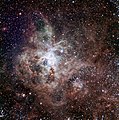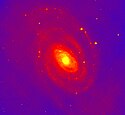Pierwsze światło
Pierwsze światło – w astronomii termin oznaczający pierwsze użycie teleskopu (lub ogólnie nowego narzędzia) w celu zrobienia astronomicznego zdjęcia po tym, jak ukończono jego budowę. Często nie jest to pierwsza obserwacja za pomocą teleskopu; testy optyczne zazwyczaj są przeprowadzane w świetle dziennym w celu dostosowania elementów. Obraz pierwszego światła zazwyczaj wywołuje niewielkie zainteresowanie naukowe i jest słabej jakości, gdyż różne elementy teleskopu muszą jeszcze być wyregulowane w celu uzyskania optymalnej wydajności. Mimo to, pierwsze światło jest bardzo ciekawe, zarówno dla osób, które projektują i budują teleskop, jak i astronomicznej społeczności, która mogła wyczekiwać momentu, gdy teleskop zostanie już zbudowany. Jako przedmiot zdjęcia zazwyczaj wybierany jest dobrze znany i interesujący obiekt astronomiczny.
Na przykład ponadpięciometrowy teleskop Hale zobaczył pierwsze światło 26 listopada 1949, kierując się na NGC 2261[2] pod kierownictwem amerykańskiego astronoma Edwina Powella Hubble’a. Zdjęcie zostało opublikowane w wielu czasopismach i jest dostępne w sieci[3].
Isaac Newton Telescope miał dwa pierwsze światła: jedno w Anglii w 1965 roku z oryginalnym lustrem, a drugie w 1984 roku na wyspie La Palma[4]. Drugie pierwsze światło było z użyciem kamery, która pokazała migający pulsar[5].
Large Binocular Telescope miał swoje pierwsze światło z jednym głównym lustrem 12 października 2005 roku. Obiektem obserwacji była galaktyka NGC 891[6][7]. Drugie główne lustro zostało zamontowane w styczniu 2006 roku, a do stanu pełnej używalności zostało doprowadzone dwa lata później[8].
Wielki Teleskop Kanaryjski wykonał pierwsze zdjęcie obiektowi Tycho 1205081 14 lipca 2007 roku[9].
Interface Region Imaging Spectrograph, satelita do obserwacji Słońca miał pierwsze światło 17 lutego 2013. Kierownik zespołu naukowego odnotował: „Jakość zdjęć i widm, które otrzymaliśmy od IRIS jest zachwycająca. To jest właśnie to, na co mieliśmy nadzieję...”.
Kosmologia
W kosmologii fizycznej, pierwsze światło oznacza światło emitowane z pierwszej generacji populacji gwiazdowych, ukształtowanych mniej niż miliard lat po Wielkim Wybuchu, których powstanie doprowadziło kosmologiczne Ciemne Wieki do końca.
Galeria zdjęć
Pierwsze światło Very Large Telescope skierowanego na NGC 5364
Pierwsze światło Kosmicznego Teleskopu Hubble’a
Mgławica Tarantula – teleskop TRAPPIST
Przypisy
- ↑ Kepler's „First Light” Images - Universe Today, „Universe Today”, 16 kwietnia 2009 [dostęp 2017-05-14] (ang.).
- ↑ 365 Days of Astronomy, 365 Days of Astronomy [dostęp 2017-05-14].
- ↑ Hubble's Variable Nebula | Caltech, archives-dc.library.caltech.edu [dostęp 2017-05-14] (ang.).
- ↑ ING, Chronology, ing.iac.es [dostęp 2017-05-14].
- ↑ Reed Business Information, New Scientist, Reed Business Information, 16 lutego 1984 [dostęp 2017-05-14] (ang.).
- ↑ LBT - First Light, 2 grudnia 2008 [dostęp 2017-05-14] [zarchiwizowane z adresu 2008-12-02].
- ↑ Large Binoccular Telescope Successfully Achieves First Light, spaceref.com [dostęp 2017-05-14] (ang.).
- ↑ BBC NEWS | Science/Nature | Giant telescope opens both eyes, news.bbc.co.uk [dostęp 2017-05-14].
- ↑ First Light for the Gran Telescopio Canarias, backreaction.blogspot.sg [dostęp 2017-05-14].
Media użyte na tej stronie
(c) TRAPPIST/E. Jehin/ESO, CC BY 4.0
This first light image of the TRAPPIST national telescope at La Silla shows the Tarantula Nebula, located in the Large Magellanic Cloud (LMC) — one of the galaxies closest to us. Also known as 30 Doradus or NGC 2070, the nebula owes its name to the arrangement of bright patches that somewhat resembles the legs of a tarantula. Taking the name of one of the biggest spiders on Earth is very fitting in view of the gigantic proportions of this celestial nebula — it measures nearly 1000 light-years across! Its proximity, the favourable inclination of the LMC, and the absence of intervening dust make this nebula one of the best laboratories to help understand the formation of massive stars better. The image was made from data obtained through three filters (B, V and R) and the field of view is about 20 arcminutes across.
This image from NASA's Kepler mission shows the telescope's full field of view -- an expansive star-rich patch of sky in the constellations Cygnus and Lyra stretching across 100 square degrees, or the equivalent of two side-by-side dips of the Big Dipper. A cluster of stars, called NGC 6791, and a star with a known planet, called TrES-2, are outlined. The cluster is eight billion years old, and located 13,000 light-years from Earth. It is called an open cluster because its stars are loosely bound and have started to spread out. TrES-2 is a hot Jupiter-like planet known to cross in front of, or transit, its star every 2.5 days. Kepler will hunt for transiting planets that are as small as Earth.
Autor: ESO, Licencja: CC BY 4.0
The spiral galaxy NGC 5364 was the first object to be observed with the VIMOS instrument. This false-colour near-infrared raw First Light image reveal extensive structure in the spiral arms of the galaxy.
The image consists of a 60 sec exposure of NGC 5364 on February 26, 2002; image quality 0.6 arcsec FWHM; full moon; field of view 3.5 x 3.5 arcmin2 ; North is up and East is left.
ID: 09e-02
Press Release: 04/02
Object: NGC 5364
Telescope: UT3/Melipal
Instrument: VIMOS
Size: 800x737
Credit: ESO
Cross Identifications: NGC 5317, NGC 5364, UGC 8853, MCG +1-36-3, PGC 49555, CGCG 46-9, IRAS 13536+0515 (Revised NGC Data for NGC 5317)This image is part of the first image taken with NASA's Hubble Space Telescope's (HST) Wide Field/Planetary Camera. All objects seen are stars within open cluster NGC 3532 in the Milky Way galaxy. Stars pictured in the HST frame are sharper than ground telescope images and well resolved, as shown by the double star at the top of the image. By avoiding the Earth's atmosphere, the HST gives sharper images and better resolution. In this early engineering picture, the HST images are roughly 50 percent sharper than the ground-based images.
Technical Details: The first image taken with the HST is intended to assist in focusing the telescope. The region observed is centered on the 8.2 magnitude star HD96755 in the open cluster NGC 3532, in the southern constellation Carina. Identical small subsections of the HST and ground-based image pictures were chosen to highlight the difference in resolution. The field shown is approximately 11 x 14 arcseconds in size and does not contain HD96755.
The HST image is a thirty-second exposure taken by the Wide Field/Planetary Camera. The picture shown was extracted from the area observed by the WF-3 OCD using the F555W broadband filter. The measured width of star profiles (FWFM) gives a good indication of the angular resolution. The FWFM of the stars in the HST picture is about 0.8 arcseconds, compared to 1.1 arcseconds for normal ground telescopes, which points out the remarkable increase in resolution of the HST even at this early stage of the focusing task.






